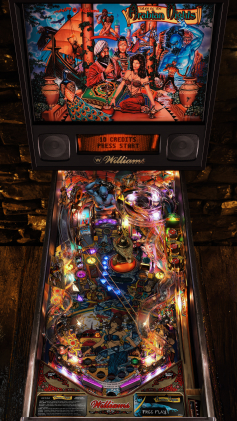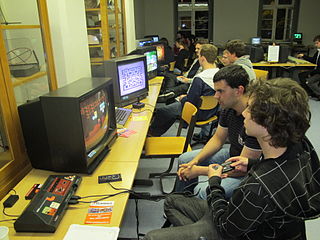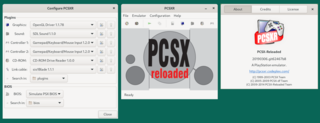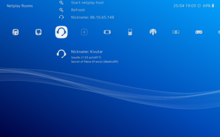
UAE is a computer emulator which emulates the hardware of Commodore International's Amiga range of computers. Released under the GNU General Public License, UAE is free software.

MAME is a free and open-source emulator designed to recreate the hardware of arcade games, video game consoles, old computers and other systems in software on modern personal computers and other platforms. Its intention is to preserve gaming history by preventing vintage video games from being lost or forgotten. It does this by emulating the inner workings of the emulated machines; the ability to actually play the video games is considered "a nice side effect". Joystiq has listed MAME as an application that every Windows and Mac gamer should have.

Visual Pinball ("VP") is a freeware and source available video game engine for pinball tables and similar games such as pachinko machines. It includes a table editor as well as the simulator itself, and runs on Microsoft Windows. It can be used with Visual PinMAME, an emulator for ROM images from real pinball machines.
VisualBoyAdvance is a free emulator of the Game Boy, Game Boy Color, and Game Boy Advance handheld game consoles as well as of Super Game Boy and Super Game Boy 2.

ePSXe is a PlayStation video game console emulator for x86-based PC hardware with Microsoft Windows and Linux, as well as devices running Android. It was written by three authors, using the aliases calb, _Demo_ and Galtor. ePSXe is closed source with the exception of the application programming interface (API) for its plug-ins.

Retrogaming, also known as classic gaming and old school gaming, is the playing and collection of obsolete personal computers, consoles, and video games. Usually, retrogaming is based upon systems that are outmoded or discontinued, although ported retrogaming allows games to be played on modern hardware via ports or compilations. It is typically for nostalgia, preservation, or authenticity. A new game could be retro styled, such as an RPG with turn-based combat and pixel art in isometric camera perspective.

Dolphin is a free and open-source video game console emulator for GameCube and Wii that runs on Windows, Linux, macOS, Android, Xbox One, Xbox Series X and Series S.

PCSX2 is a free and open-source PlayStation 2 emulator for Windows, Linux, and macOS that supports a wide range of PlayStation 2 video games with a high level of compatibility and functionality. Although PCSX2 can closely mirror the original gameplay experience on the PlayStation 2, PCSX2 supports a number of improvements over gameplay on a traditional PlayStation 2, such as the ability to use resolutions up to 8 times larger than native, anti-aliasing and texture filtering.

PCSX is a free and open-source, video game console emulator that allows software designed to be used with the Sony PlayStation to run on personal computers. Over the years, development changed hands several times with PCSX-Reloaded (PCSXR) now being the main version. As of 2021, the emulator seems to be no longer under active development. A newer, actively maintained fork of PCSX-Reloaded is PCSX-Redux.

Stella is an emulator of the Atari 2600 game console, and takes its name from the console's codename. It is open-source, and runs on most major modern platforms including Windows, Mac OS X, and Linux. Stella was originally written in 1996 by Bradford W. Mott, and is now maintained by Stephen Anthony.

Higan is a free and open source emulator for multiple video game consoles, including the Super Nintendo Entertainment System. It was developed by Near. Originally called bsnes, the emulator is notable for attempting to emulate the original hardware as accurately as possible through low-level, cycle-accurate emulation and for the associated historical preservation efforts of the Super NES platform.
The ODROID is a series of single-board computers and tablet computers created by Hardkernel Co., Ltd., located in South Korea. Even though the name ODROID is a portmanteau of open + Android, the hardware is not actually open source because some parts of the design are retained by the company. Many ODROID systems are capable of running not only Android, but also regular Linux distributions.
Mupen64Plus, formerly named Mupen64-64bit and Mupen64-amd64, is a free and open-source, cross-platform Nintendo 64 emulator, written in the programming languages C and C++. It allows users to play Nintendo 64 games on a computer by reading ROM images, either dumped from the read-only memory of a Nintendo 64 cartridge or created directly on the computer as homebrew.

Mednafen, formerly known as Nintencer, is an OpenGL and SDL multi-system free software wrapper that bundles various original and third-party emulation cores into a single package, and is driven by command-line input. It is distributed under the terms of the GPL-2.0-or-later license. Certain emulation cores of Mednafen have been ported to RetroArch/Libretro.

OpenEmu is an open-source multi-system video game emulator designed for macOS. It provides a plugin interface to emulate numerous consoles' hardware, such as the Nintendo Entertainment System, Genesis, Game Boy, and many more. The architecture allows for other developers to add new cores to the base system without the need to account for specific macOS APIs.

PPSSPP is a free and open-source PSP emulator for Windows, macOS, Linux, iOS, Android, Nintendo Wii U, Nintendo Switch, BlackBerry 10, MeeGo, Pandora, Xbox Series X/S and Symbian with a focus on speed and portability. It was released to the public on November 1, 2012, licensed under the GNU GPLv2 or later. The PPSSPP project was created by Henrik Rydgård, one of the co-founders of the Dolphin emulator.
RetroN is a series of video game consoles created and developed by Hyperkin which allows users to play video games from consoles such as the Nintendo Entertainment System and the Super NES. Since the release of the RetroN 5, they have been connected via HDMI. The latest in the series, RetroN Sq, was released in 2021.

GPD XD is an Android-based handheld game console produced by the Chinese company GamePad Digital, released in late 2015. It is similar in form to a Nintendo 3DS XL, has a single, capacitive touch-screen, and is optimized for running emulators and other native Android software. It was succeeded by the GPD XD Plus, which has a smoother hinge and runs on Android 7.

GDevelop is a 2D and 3D cross-platform, free and open-source game engine, which mainly focuses on creating PC and mobile games, as well as HTML5 games playable in the browser. Created by Florian Rival, a software engineer at Google, GDevelop is mainly aimed at non-programmers and game developers of all skillsets, employing event based visual programming similar to engines like Construct, Stencyl, and Tynker.














